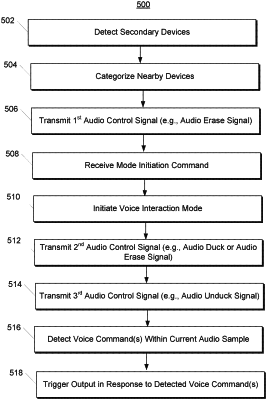| CPC H04L 12/2821 (2013.01) [G06F 3/165 (2013.01); G10L 15/22 (2013.01); G10L 17/00 (2013.01); H04L 12/2814 (2013.01); H04L 67/51 (2022.05); H04R 27/00 (2013.01); H04L 2012/2849 (2013.01); H04R 2227/003 (2013.01); H04R 2227/005 (2013.01); H04R 2430/01 (2013.01)] | 20 Claims |

|
1. A computer-implemented method comprising:
detecting, by a primary computing device, one or more secondary computing devices configured to generate audio streams for audible output in an environment, wherein the primary computing device and the one or more secondary computing devices are communicatively coupled via a network;
categorizing, by the primary computing device, at least one of the one or more secondary computing devices as a nearby device when such a secondary computing device is determined to be capable of providing audio streams near the primary computing device, wherein the categorizing is based at least in part on data obtained by the primary computing device via the network;
initiating, by the primary computing device, a voice-interaction mode for operating the primary computing device to receive voice commands from a user and provide audio output in response to the voice commands; and
transmitting, by the primary computing device to each nearby device, a signal that causes the nearby device to reduce a volume level associated with the audio stream generated by the nearby device while the primary computing device is operating in the voice-interaction mode.
|